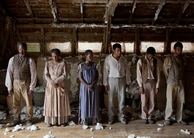Room for DebateIntelligent Design in the Complexity of the Human Body
By
2015, Vol. 7 No. 03 | pg. 1/2 | »
KEYWORDS:
In a previous article I wrote about fine-tuning in the Universe and the empirical evidence for a Grand Designer that can be found within our reality. This argument of course occurs within the context of ongoing fiery debate between theists and secular scholars, and so, in the pursuit of academic harmony and scholarly camaraderie I will once again attempt to shorten the chasm between science and religion. However, instead of examining the Universe and the order that can be found within its laws, in this piece I examine the complexities of the human body and its mutualistic relationship with Earth and how this relationship supports the idea that the Earth was fine-tuned for life by a Creator. When nature is examined closely it seems impossible to ignore the design in its symmetry.
I will also attempt to debunk some commonly cited atheistic and secular arguments in order to better support my position. It is important to note that in this paper I do not attempt to support nor condone any one religion, rather I assert the idea that human beings were not created by a series of chaotic incidences and random circumstance. When examining the complex nature of the human body as well as the anatomical functions of all living beings one can begin to see a design present in the inner-machinations of how a body functions. Often intelligent design is referred to as pseudo-science; a futile attempt by theists to assert that God exists through the study of science and the reality that human beings occupy. However, when examining the complexities found in the human body it seems nigh impossible to notice symmetry and design within the functions of the human body. For instance, the human brain is one of the most mysterious and enigmatic organs of the human body. It serves as the vehicle for the most primal desires as well as the most evolved functions of human beings. Everything from the desire to eat and sleep to the ability to engage in intellectual civil discourse is held within the human brain.Theist scholar Dr. Brad Harub discusses the complex functions of the human brain and its relationship with the nervous system in his article “The Human Nervous System: Evidence of Intelligent Design [Part I]” and states that “Synaptic vesicles are loaded with specific neurotransmitters that are then delivered to the end terminal of the axon. Upon activation, these vesicles will “dump” their contents into the synaptic cleft (the space between nerve cells). This action requires the nerve cell to be able to manufacture neurotransmitters... How could anyone critically evaluate this system and then ignore the manifestly evident design?” (Harub.) In this article, Harub examines the complexities of the human brain and nervous system, and extrapolates on the assertion that the relationship between the two contains a meticulous series of functions and relationships that are far too complex to have happened by mere accident. Previously, I examined how the universe and its laws exhibited a uniformity that implied design, in this paper I will examine how the human body shares the same complexities and uniformities that yield evidence for intelligent design. When utilizing the uniformity of the universe and its laws as a vehicle for pro intelligent design arguments, one must also acknowledge how the human body can serve the same function. All of the separate parts of the human body work in tandem in order to produce a being that has cognitive capabilities that are unmatched by any other species on planet Earth. The human nervous system works in tandem with the brain to allow humans to feel the spectrum of human emotions. Everything from excruciating pain to utter elation is caused by the brain and its relationship with the nervous system. Secular scholars will assert that these capabilities came by way of random chance and natural selection. When examined, this statement lacks logical validity. For instance, years of innovation and human creation have yielded the computer, an invention capable of processing vast amounts of information. The computer had a designer, and continues to be built upon even today. However, despite all of its capabilities the computer pales in comparison to the power of the human brain. Ryan Whitwam writes in his article “Simulating 1 second of human brain activity takes 82,944 processors” that “It took 40 minutes with the combined muscle of 82,944 processors in K computer to get just 1 second of biological brain processing time. While running, the simulation ate up about 1PB of system memory as each synapse was modeled individually.” (Whitwam.) In this article, Whitwam examines the complexities of the human brain and how despite all of the innovation, the human mind could not create an object that could exhibit the powers of the human brain. This point helps support the idea that the human brain and other parts of the body have a designer that is capable of feats that are unfathomable to humans. The human body is comprised of an amalgamation of different systems that together make a complex organism that exhibits symmetry and order. The aforementioned function of the brain and the nervous system exhibit a symmetry and complexity that warrants a belief in a grand designer. Of all the systems in the human body, one of the most complex is the circulatory system. Once again, theistic scholar Dr. Brad Harrub comments on the complexity of the human circulatory system and how its physical make-up yields evidence for design “Furthermore, evolutionists must explain how the heart and vessels came to be so well laid out within the human body—how the heart came to be protected by a bony cage, and how the vessels are able to navigate around bones. Are we to believe that this was simply a “trial-and-error” experiment of nature over millions of years?” (Harrub.) In this article, Harrub extrapolates on the complexities of the human circulatory system and how its inner-machinations seem to indicate a grand design, as well as how it is unlikely that random circumstance is responsible for the heart and circulatory system present in all living beings. The heart contracts and pumps blood involuntarily; no cognitive thought is required to maintain this necessary act of life and yet the human heart continues to beat. Harrub extrapolates on these complexities by stating that “If “natural selection” were able to explain the existence of a chambered heart (and the progression from two to four chambers), then it must also give an indication of the origin and evolution of the nerve innervation responsible for heart contractions” (Harrub.) While natural selection may suffice for those who adhere to secular Darwinism, for scholars like Harrub it is simply not enough to explain the complexities of the human circulatory system and the mysteries surrounding its seemingly autonomous function. If chance and circumstance had created the human heart and circulatory system, one could expect numerous anomalies and random inconsistencies. And while disease and environmental factors may cause problems in the heart, circulatory system, brain, and nervous system for most human beings our brains continue to function without issue, helping us express a range of emotions, our hearts continue to autonomously and independently pump blood throughout our bodies; feeding our muscles, and our nervous system continues to function in accordance with our brain allowing for all aforementioned functions to carry on without problem or interruption. Another amazing function of the human body is the act of conception. Often theistic scholars will examine how human beings and other animals are conceived and the process of their evolution from conception to birth and use this as a medium to assert their belief in a higher power. Despite all of our complexities, every human being began and every animal as a series of ever-dividing cells, relatively simple in nature, yet eventually culminating into an incredibly complex being. For humans, this complex series of cellular divisions and growth begins at conception. Distinguished anatomy professor Keith L. Moore examines the very beginning of human life and the complex process of cell growth in his work titled “Essentials of Human Embryology” by stating that “Human development begins after the union of male and female gametes or germ cells during a process known as fertilization (conception). Fertilization is a sequence of events that begins with the contact of a sperm (spermatozoon) with a secondary oocyte (ovum) and ends with the fusion of their pronuclei (the haploid nuclei of the sperm and ovum) and the mingling of their chromosomes to form a new cell. This fertilized ovum, known as a zygote, is a large diploid cell that is the beginning, or primordium, of a human being." (Moore 2.) Here, Moore examines the complexities of conception in great detail; how the chromosomes from both the ovum and the cell fir together to form a brand new cell. This incredibly small cell then divides and grows. All of our thoughts, capabilities, feelings and bodies began as a series of microscopic cellular divisions. Now, while complications do arise in birth through mutation and genetic anomalies, over all it functions like clockwork. It is difficult to examine conception, the division of cells, and the evolution from zygote to fetus and not see a rigorous and meticulous series of patterns begin to emerge. If random occurrence and simple chaotic incidence had been the cause for human life, one could expect a far greater number of genetic anomalies in human beings. The symmetry of the human body from conception to birth is overwhelming, and it seems illogical to assert that random occurrence is responsible. The human body contains a variety of complex systems and organs that together allow us to breathe involuntarily; our hearts beat autonomously pumping blood throughout our circulatory system. Our brain and nervous system are more powerful and complex than any computer made by man, and yet one of the most impressive organs in the human body and a sure sign for design is the human eye. The anatomy and inner-machinations of the eye’s functions are extremely complicated and require a vast system of chemical reactions and interaction with the nervous system in order to produce the spectrum of color we see and how we perceive the world around us. More specifically, it is even more astounding at how our brain works in tandem with our eyes in order for humans to comprehend the information that our eyes gather. Creationist Jonathan Safarti writes in his article “Refuting Evolution Part. 2” that ” Similarly, the first curving, with its slight ability to detect the direction of light, would only work if the creature had the appropriate ‘software’ to interpret this. Perceiving actual images is more complicated still.” In this article, Safarti refutes the atheist naturalist assertion that the eye came about through random natural selection. The chemical and muscular make-up of the eye and its functions is often used for arguments supporting intelligent design, and rightly so. It seems highly unlikely that evolution alone is responsible for the highly complex nature of the eye’s functions. While scientists can trace the evolutionary track of the eye, how our brain interprets the spectrum of colors and organizes it into rational information instead of just sheer randomness seems to be far too complex to be explained through evolution alone.Continued on Next Page » Suggested Reading from Inquiries Journal
Inquiries Journal provides undergraduate and graduate students around the world a platform for the wide dissemination of academic work over a range of core disciplines. Representing the work of students from hundreds of institutions around the globe, Inquiries Journal's large database of academic articles is completely free. Learn more | Blog | Submit Latest in Opinion |



















